Everton Independent Research Data
DUNDEE’S NEW MANAGER
Dundee Evening Telegraph - Friday 06 July 1928
LOCAL FOOTBALLER APPOINTED TO-DAY
PLAYED CRICKET FOR FORFARSHIRE
Mr. James Bisset, a Dundee man and a footballer of large experience, is the new manager of Dundee F.C. The appointment was made this forenoon. Mr. Bisset played as a junior with Forthill Athletic, and started his senior career with Arbroath, from where he went to Dens Park. After a term there he went to England and played for Everton, Middlesbrough, and Lincoln City, finished up last season with the latter club. He was a splendid back. He is also well known on the cricket field. He played for quite a while in Lochee Park cricket, and latterly went to Forthill, where he assisted the Forfarshire first eleven on many occasions, being a wicket-keeper of no mean ability. Since his return from English football he has been playing in local cricket at Lochee Park. Mr. Bisset, who is an old Harris Academy boy, start on his new duties immediately.
FINE MATCH IN PROSPECT
Star Green 'un - Saturday 07 July 1928
Everton, the Football League champions are to play Glasgow Celtic at Glasgow next September in a benefit match for Mr. W. Maley, the famous manager, who was so fine a footballer in his playing days. Celtic will play Everton at Goodison Park next Easter. It should be a fine match and the fixture reminds me of the time when Sheffield Wednesday used to meet the crack Scottish teams.
NEW MANGER FOR DUNDEE F.C.
Dundee Courier - Saturday 07 July 1928
FOOTBALLER-CRICKETER APPOINTED
The appointment of Mr. James Bisset, a former Dundee footballer, to the position of manager of Dundee F.C., was made yesterday. Mr. Bisset, who is 30 years of age, is a native of Dundee, and a former pupil of the Harris Academy. He made his debut in football with Forthill Athletic, and started his senior career with Arbroath United. In 1919 he was signed by the former manager, Mr. Alex Macfarlane, and Mr. William McIntosh for Dundee F.C., and played many fine games for them at right back for two seasons. Transferred to Everton, Bisset played there for two years, he was transferred to Darlington. After a spell with Middlesbrough he went to Lincoln City last year, finishing up with the club at the end of the past season. Mr. Bisset also made his mark on the cricket field, and some years ago assisted the Forfarshire first eleven, being a capable wicket-keeper. He has played frequently for the local Inverary, and has been picked for the Lochee Park select team to meet Forfarshire on Thursday. Mr. Bisset who is married, resides at 35 Roseberry Street.
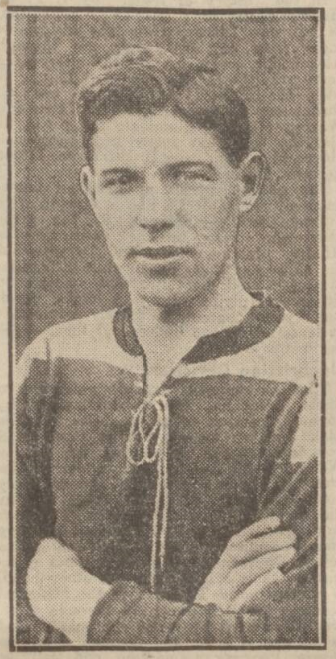
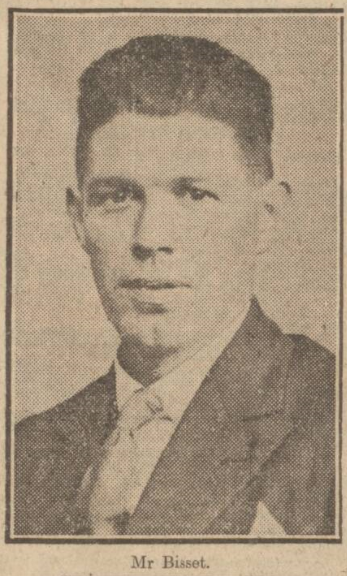
STUD MARKS
Liverpool Echo - Saturday 07 July 1928
By Louis T. Kelly
- A reader wants to know if the following four goalkeepers were on the Everton books at one an d the same time;- Roose, Williams Scott, Kitchen, and Whitley
- We cannot trace this as being so
- Kitchen joined Everton in 1898, and became Everton’s recognized League team goalkeeper to the wend of 1903-04
- Whitley joined up shortly after Kitchen, but made few League team appearances
- William Scott joined for 1904-5 season, and Roose midway through the same campaign, but we fancy Kitchen or Whitley (possibly both) left Everton at the close of season 1903-04
- Jack Peacock assisted Middlesbrough in thirty-five matches last term
- After beating Everton 5-2 at Goodison Park last winter, the Spurs only won two of their remaining fourteen engagements.
- Dick Forshaw got among the prizes at last week’s charity bowling tournament at Waterloo
- While his clubmate Dean, was to the fore as referee in the finals.
LOR THE LORE!
Liverpool Echo - Wednesday 11 July 1928
Mr. W. Eyton writes:—in answer to letter from Jack Douglas of the second eleven of the Everton F.C., (1882), I can inform him that T. Williams, also Tom Scott Ben Hilton, and Willie Parry are still alive, but Tom Evans, our first team captain, is no more. T. Williams, who well be eighty-two years next birthday, can be seen any Tuesday or Friday on the Liverpool Corn Market. I must call his memory up, as the notch tie refers to was not Halliwell but Bolton Wanderers; also that the late William Gibson was the centre-forward and never played half-back: his brother Stephen Gibson played half-back in the second team, and he died in 1886. The match was played with six forwards, and I being one of the collectors know we collected the handsome sum of sixteen shillings and two-pence around the ropes! After the match we entertained the Bolton players, to tea, which was provided by the members of the Everton Club. I am informed one of or old half.-backs of the eighties (W. H. Jones), that Tom Keates is compiling a book of the old club. I hope he will remember the old names. He may remember the St. Benedict players, who joined Everton in 1884:--Charley Joliffe, Arthur Brown, Will Bolton, Fred Shiel, W. H. Jones, Walter Richards, Frank Richard.. Willie Briscoe, J. Shears, Jack Whittle, Tom Whittle, Mike Higgns, Jimmy Higgins, Teddy Jones, Will Bolton, Arthur Bolton, also Walter Mowbray, Edwin Berry, J. Asbury, and T. Bargary. The matches played by the second team were Oakfield Rovers, St. Mary’s, Kirkdale; Linacre Gas Works, Linacre Bible Class, Brunswick Rovers, Fairfield Olympia, Birkenhead Argyle, St. Gabriel’s, St.Peter’s, Ormskirk Wanderers, Peasley Cross, Haydock, Prescott, Bromborough Pool, and Aigburth Vale.
Billy Muir’s Interests.
Sunday Post - Sunday 15 July 1928
A FEW years ago I met at Aintree races —on the day that Jack Horner won the Grand National Steeplechase at 25 to 1 —a gentleman introduced to by Neil M'Bain, of Everton, Billy Muir.” At that time I did not realise that Billy Muir at one time was a famous goalkeeper. I learned soon afterwards, however, that ho had kept goal for no fewer than four leading clubs—Everton, Dundee, Bradford City and Hearts. Billy still keeps up big Hearts’ connection, and frequently meets those other Hearts’ stars, Bobby Walker, and Paddy Crossan, in Edinburgh or Musselburgh. The ex-Hearts goalkeeper is very keen race-goer,” and delights in fraternizing with old players such as Neilly Gibson, James M'Menemy, and J. H. Logan when the Scottish racing circuit is on.
A ONE-WAY ROUTE
Athletic News - Monday 16 July 1928
I have seen Everton and the Middlesex Wanderers during their Continental tours. I am sorry to have to confess that the English Championship team left behind a mediocre impression. We, in Switzerland, fully know that holiday feeling of English professional teams, and are quite satisfied if they teach us something about the technical and tactical part of the game. The understanding between half-backs and backs was excellent, and the authority of the goalkeeper within the penalty area taught us something, but Everton did not reach the high scientific standard of the leading professional clubs of Vienna, Budapest, and Prague. What about the mechanically working attack, that continual pass to the centre-forward, lying well ahead, irrespective of his being well covered? The inside forwards seemed to be slaves trained to do the one and only thing- to hang well behind and pass the ball to the centre-forward. B. Scherrli. Baden, Switzerland.
FREE STATE “OPEN DOOR
Daily Mirror - Tuesday 17 July 1928
Joe Kendrick, who played for Everton last season, and is a speedy outside left, has signed for Dublin Shelbourne.
EVERTON AMAETUERS
Liverpool Echo - Tuesday 17 July 1928
By Blackstaff Notes
The football season is drawing nigh, and clubs are on the lookout for new players. Amateurs who “fancy their chances,” and would care to step into a higher class have an opportunity to prove their worth, for the Everton Football Club invite applications for a trial at Goodison Park. Now’s your chance. Write Mr. T.H. McIntosh, Goodison Park, as soon as you like.
ANOTHER NEW PLAYER FOR NELSON.
Burnley Express-Wednesday 18 July 1928
Nelson have signed- Thomas Wilkinson, inside forward, who for the last two seasons has been with Everton. He is 24 years of age, stands 5ft. 8 ½ ., and scales list. 71b.
NEW FORWARD FOR NELSON.
Burnley News - Wednesday 18 July 1928
During the week-end inside forward, Thomas Wilkinson, has been signed for Nelson F.C. by Mr. J. English, the manager of the club. Wilkinson who has been on Everton's staff for the past two seasons, is 24 years of age, 5ft 8ins, and weighs 11st 7lb.
PLAYERS MOVEMENTS
Blyth News - Thursday 19 July 1928
Tom Wilkinson, the ex-Blyth Spartan forward, has signed on for Nelson. A native of Pelton Fell, Wilkinson went to Hull City in the 1924-25 season. Two seasons later he was in the service of Chester-le-Street, from whom he joined the Spartans in December 1926. In the following March the Spartans transferred hi to Everton along with “Billy” Easton (Blyth), the two securing agreements to the end of last season. Easton was re-engaged by Everton for next season, but Wilkinson was given a free transfer.
EVERTON SIGN CENTRE
Liverpool Echo - Monday 23 July 1928
Blackstaff Notes
It is a sign of the times when Walton 63 telephones to Central 3400. Everton this morning announce that they have signed a promising centre-forward named N.H. Williams, who is 5ft 9in, and weighs 11st. He is a Birkenhead boy, who used to play in school games against Dean. He was one of the Thurstaston Camp brigade first of all, and last season he was with Tuebrook Vics. Tranmere Rovers gave him a trial, but evidently did not think his worthwhile signing. Mr. Danny Kirkwood paid testimony to the value of the “Answers and Challenges” column, the club’s application for amateur players met with a greater response than ever before. “We got flooded of replies, and Mr. Danny Kirkwood someone who will turn out trumps.
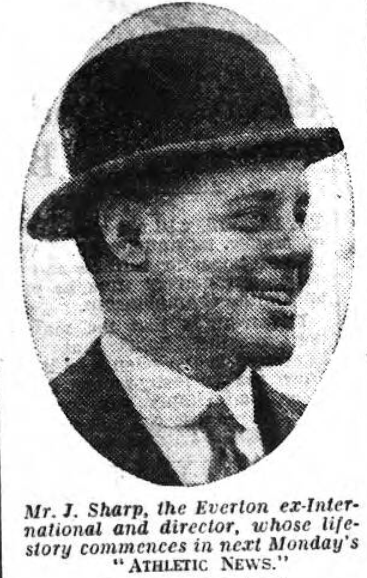
U.S.OFFER TO DEAN
Belfast News-Letter - Monday 30 July 1928
EVERTON CENTRE-FORWARD REFUSES £25 A WEEK
EX-DISTILLERY PLAYER GOES
That Dean, the famous Everton and English international centre forward, has received a stupendous offer to play in America, was disclosed on board the White Star Liner Cedric prior to the vessel’s departure from Liverpool for New York on Saturday, by Mr. George Moorhouse, manager of the New York Giants Soccer team, who was on board, accompanied by three English League players who have signed agreements to play for his club next season. The three players are; D. McMullan, the Irish international half-back of Liverpool, who was formerly with Distillery; E. Glover, who has played for Everton, Southport, New Brighton, and Wigan Borough; and J.C. Harrington who has had service with Liverpool, Luton and Millwall. “Soccer American is rapidly gaining in popularity,” Mr. Moorhead said, “and the schools have started to play the game. The American Soccer League consists of 11 professional team, which are composed mostly of imported players and the gate attendance average from 5,000 to 10,000 per match the price of admission being the equivalent of 4s 8d, all spectators paying the one price in order to give the game a boost. “We offered Dean, the English centre forward, £25 a week,” added Mr.Moorhead, “to play in America, but our overtures were unsuccessful. Dean said he preferred to play in England. McMullan, who I am taking with me now, is on Liverpool’s transfer list for £650, but we obtained him without paying a fee, as the English Football Association have no jurisdiction over us. With us McMullan will be paid £10 a week. “First class American football,” Mr. Moorhouse concluded, “is about on a par with that of English’s Second Division League,” Mr. Moorhouse at one time played with Tranmere Rovers, but he left in 1923 in order to proceed to America.
MISSED BY DERBY COUNTY.
Derby Daily Telegraph - Monday 30 July 1928
What Happened to International Footballer. How Mr. Jack Sharp, the cricket and soccer international, who is now director of Everton football club, and his brother Bert were missed Derby County is told in to-day's "Athletic News." Mr. Sharp states I made my mind to qualify for the Lancashire Cricket Club, and but for this ambitions should have joined Derby County, who wanted Bert and I to play for them. “We have practically arranged to go to Derby, and were to have met their officials at Birmingham to talk the matter over, but q, friend of ours had been in communication with Everton. " I think it was the very same day that we should have met the Derby officials that Everton came to the Villa ground and secured our transfers. Mr. Harry Newbold, then Derby County's secretary, was very sore about it. “He had never dreamt missing us, and no one had we any thought of the likelihood of joining Everton until this rapid development.' “I was with Everton eleven seasons and Bert about a couple, after which he joined Southampton. Throughout my eleven years with Everton I never played in the second team.
AMERICA'S FOOTBALL QUEST.
Hull City -Monday 30 July 1928
OFFER TO " DIXIE " DEAN REFUSED.
Three English League players accompanied George Moorhouse, the manager of the New York Giants Soccer team, on tne White Star liner Celtic, which left Liverpool for New York on Saturday. players are:— D. McMullan, the Irish International half back, Liverpool, F.C.. C. K. Glover, who has played for Everton, Southport, New Brighton and Borough, and J. C. Harrington, formerly with Liverpool, .Luton Town, and Millwall. They have all signed agreements to play for the New York next season. America is still prepared to pay large sums for really first-class English footballers. It is stated that a bid was made for Dixie ' Dean, the Everton and England Inter national centre forward, tho terms offered being a week. Dean, however, preferred to remain England, and the overtures were not successful.
From Wikipedia
Charles Edward "Teddy" Glover (7 April 1902 in Bootle , Liverpool, England – 8 February 1993 in Pueblo, Colorado ) was a US soccer full back who began his career in the lower English divisions before playing several seasons in the American Soccer League . He is a member of the National Soccer Hall of Fame. In August 1922, Glover began his professional career with New Brighton A.F.C. of the English Third Division North . On 14 July 1925, he moved to Southport F.C. for two seasons. On 5 August 1927, he was transferred to Wigan Borough F.C. . In 1928, he moved to the United States where he signed with the New York Giants of the Eastern Soccer League . The Giants moved to the American Soccer League in 1930, playing as the New York Soccer Club . In the spring of 1931, Glover moved to the New York Giants. However, this was a different team than the previous Giants. When the first Giants renamed themselves the New York Soccer Club, the owner of the New York Nationals decided to rename the Nationals the Giants. In the spring of 1931, the Giants won the ASL championship. The Giants folded after the spring 1932 season and Glover moved to the New York Americans . The first ASL collapsed in the summer of 1933, to be replaced by the second ASL. The Americans moved to the new league. In 1934, Glover joined Brookhattan of the ASL, remaining with them until 1940. He then finished out his career with Pfaelzer S.C. of the German American Soccer League and Brooklyn S.C.
Glover was inducted into the National Soccer Hall of Fame in 1951.
Teddy also served as an assistant coach at the University of Southern Colorado (now CSU-Pueblo) in 1991 and 1992.
Born 7 april 1902, Bootle, Liverpool
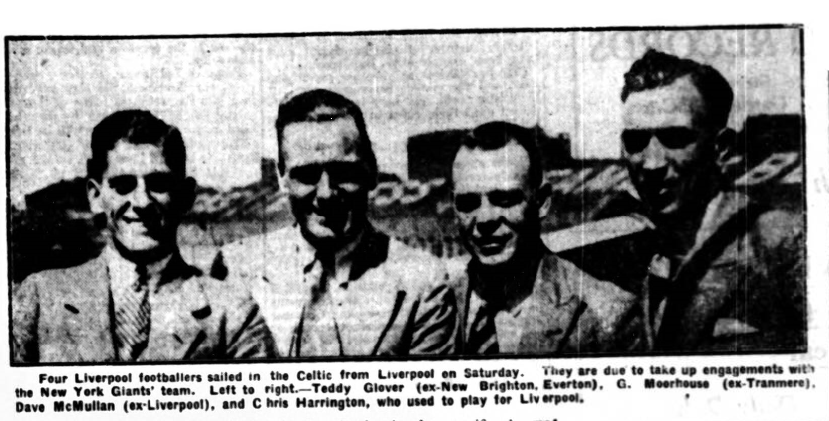
Athletic News - Monday 30 July 1928
Making Records at 17
Cricket Ambition Which helped to Mould Soccer Career
Mr. Jack Sharp, Everton
Football history contains many a romantic story of the Fates shaping the career of famous players. Mr. Jack Sharp, the cricket and Soccer International, who is now a director of the Everton club, with which he gained practically ever distinction football offers, might have been a Derby County player but for his eagerness to qualify for Lancashire county cricket, in which he began as a professional and ended as an amateur and captain.
Interview by Tee
The average Englishman’s mental picture of a first class all-rounder in sport is a bronzed, sturdily set figure, whose merry smile instantly conveys this message; “I am in perfect health and getting the maximum of pleasure out of life.”
Mr. Sharp, now a director of the club he used to play for in football –Everton is and always has been a model of the type I have described. Love of sport is so deeply ingrained in him that it may be said to be his whole existence. The story of his career shows that nature intended him to have an open-air life – the life of the playing fields –and he entered upon his profession unusually early. At the age of 17 he was creating records as a centre-forward at Hereford with a club named Heresford Thistle, who won the championship of the Bristol and District League at a time when the reserve teams of Aston Villa and Small heath, (forerunners of the present Birmingham clubs were in membership. His elder brother, Bert, was a full-back in the same side, and Jack figured in one of the first representative matches the Bristol League played –against Aston Villa in the season before this great Midland club won the Cup and League championship in 1897. The play of the brothers Sharp so impressed Aston Villa that a year later both were secured by Mr. A.G. Homer, then the Villa assistant secretary and later secretary of Bristol Rovers. At that time Jack was cricket professional to Leyland, the Lancashire club, which was then, and for many seasons afterwards, one of the best club sides in the North, and the arrangement whereby he went to the Villa was made in an interview at Preston. In the following season he made his League debut for the Villa, and figured in about half their first team matches, as a centre-forward. In the following season however, the famous Charlie Athersmith was out of the team through some cause and Jack was tried at outside right. He partnered Jack Devey and took part in nearly a score of matches with the first team, but Athersmith’s return led him to the conclusion that he had no prospects with the club and he joined Everton. He chose Everton for a two-fold reason. One was that the club wished to secure his services and the other he explained as follows;
“I had cricket in view as well. I had made up my mind to qualify for Lancashire. But for this cricket ambition I should have joined Derby County, who wanted Bert and I to play for them. “We had practically arranged to go to Derby, and were to have met their officials at Birmingham to talk the matter over, but a friend of ours had been in communication with Everton.
Why Derby “Missed” Us.
“I think it was the very same day that we should have met the Derby officials that Everton came to the Villa ground and secured our transfers. Mr. Harry Newbould, then Derby County’s secretary, was very sore about it. “He had never dreamt of missing us, and no more had we any thought of the likelihood of joining Everton until this rapid development. “I was with Everton eleven seasons and Bert about a couple, after which he joined Southampton. In my first season at Goodison Park I was chosen to play for the League against the Irish League, and ultimately I secured every distinction in the game except that of playing in an inter-League match against Scotland. “I was always pretty fast, and won dozens of prizes as a boy. When I joined the Villa we used to do a lot of sprinting, and Athersmith, the fastest footballer of his time, used to give me one and a half-yards start in seventy, I beat him fairly often.
Never In Second Team
“My first League match was for the Villa against Bolton Wanderers, and I got two of three goals for our side. I was centre forward then, and J.W. Sutcliffe was the Wanderers goalkeeper I think he was as good a goalkeeper as ever played. “My two international appearances were in 1903 and 1905. I played inside right against Ireland at Wolverhampton, and outside right against Scotland at the Crystal Palace. The change of position was not a handicap on account of my earlier experience as an inside forward, but I was outside right in my three inter-League games –all against Ireland. “The reason why I did not play against Scotland in an inter-League match was that I broke down in a Cup replay in mid-week at Bolton. That was in the year Everton won the Cup -1906. “The worst accident I ever had in football was when playing against Everton for the Villa. In trying to push the ball out to a wing man I kicked under the foot of D. Storrier, Everton’s left back, and though I played throughout the match my instep was so badly damaged that I could not put my foot on the ground for a fortnight afterwards. “Throughout my eleven years with Everton I never played in the second team. Although I played in about 400 matches for the Club.” (To be Continued).
FOOTBALL CALL-UP
July 31 st 1928. The Liverpool Courier.
Players of the Everton club report for training at Goodison Park this morning, but serious work will not begin until tomorrow.
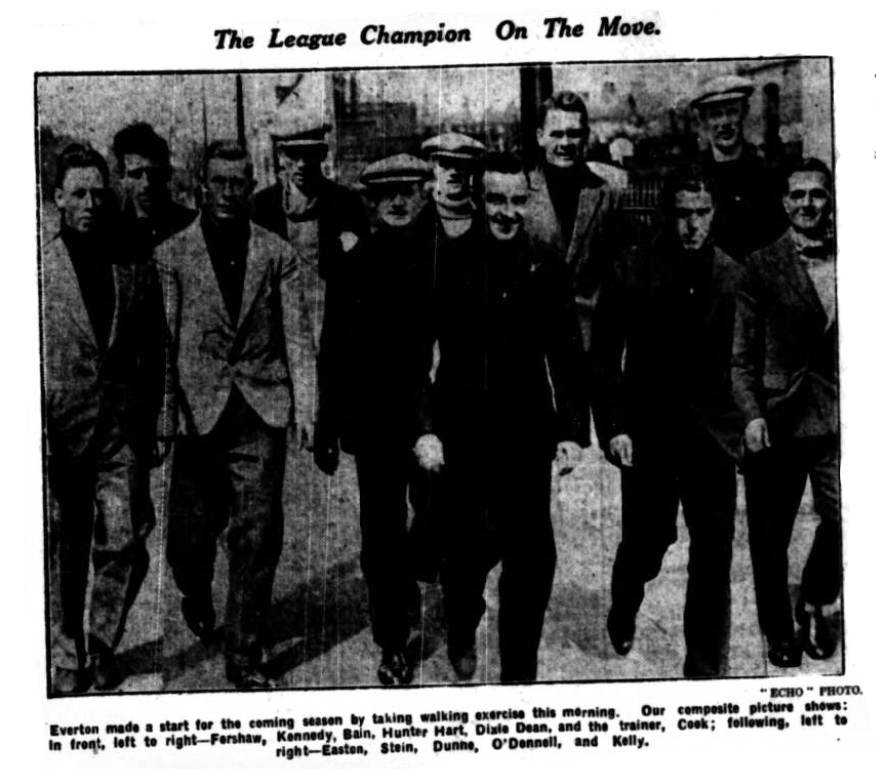
July 1928